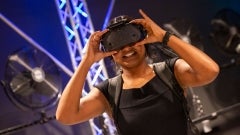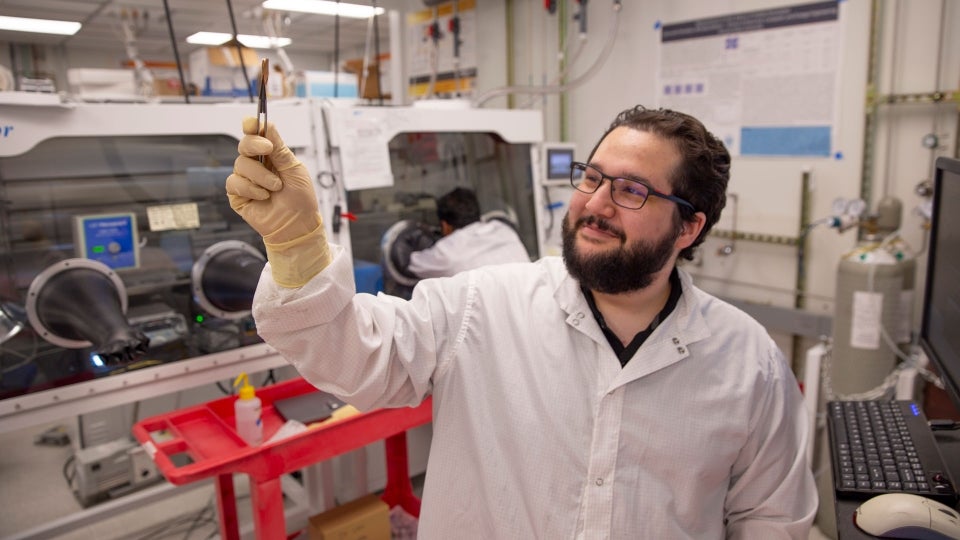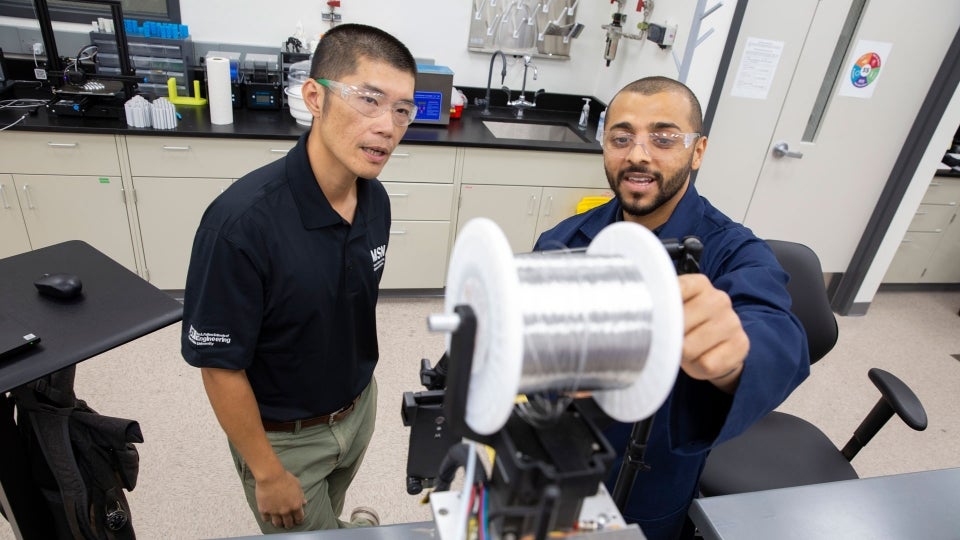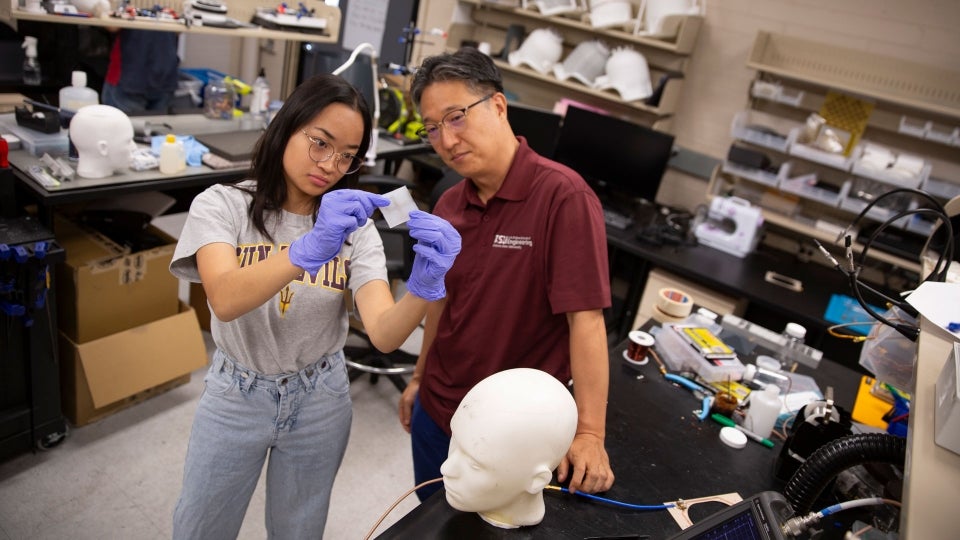Expo features student researchers solving real-world challenges

Arizona State University biomedical engineering junior Ava Claire Lariego (left) works with SungMin Sohn (right), an assistant professor of biomedical engineering, to develop a new material to improve MRI scans. As a student in the Fulton Undergraduate Research Initiative, Lariego is one of many student researchers helping to solve real-world problems with hands-on research. Photos by Erika Gronek/ASU
Visualizing data in virtual reality, advancing microelectronics performance and longevity, using vibrations to improve metal 3D printing, and improving MRIs with new materials are several ways Arizona State University students are addressing real-world challenges through hands-on research.
Undergraduate and graduate students in the Ira A. Fulton Schools of Engineering at ASU have several opportunities to apply their knowledge outside of the classroom through research.
The Fulton Undergraduate Research Initiative, or FURI, and the Master’s Opportunity for Research in Engineering, or MORE, programs give participants valuable experiences in which they conceptualize ideas, develop plans and investigate their research questions over a semester.
Students participating in the Grand Challenges Scholars Program, or GCSP, can apply for additional funding to conduct research through the GCSP research stipend program. Conducting research is part of a GCSP student’s rigorous competency requirements designed to prepare them to solve complex global societal challenges.
Each semester, students who participate in FURI, MORE and the GCSP research stipend program are invited to present their findings at a poster session. Formerly known as the FURI Symposium, the Fulton Forge Student Research Expo is the culmination of the students’ hard work to forge meaningful research paths and connections to make an impact.
Learn about four students who are participating in the fall 2023 Fulton Forge Student Research Expo, which will take place from 1 to 3 p.m. Nov. 17, at the Student Pavilion on ASU's Tempe campus, and is open to the public.
Neha Balamurugan

A student in ASU's Barrett, The Honors College and computer science junior, Neha Balamurugan is a GCSP student conducting research to help students better visualize data through virtual reality. She has participated in research since her first year at ASU and has gained new skills to apply to her passion for math and puzzles in impactful ways.
Her current research, supported through the GCSP research stipend program, is advancing her work to address the National Academy of Engineering Grand Challenge theme of "Joy of Living." Balamurugan has been working in this research area for several semesters with Robert LiKamWa, an associate professor of electrical and computer engineering in the Fulton Schools with a joint appointment in ASU’s School of Arts, Media and Engineering.
Question: What made you want to get involved in this program? Why did you choose the project you're working on?
Balamurugan: For my "National Science Foundation Research Experiences for Undergraduates" project in the summer of 2022, I worked with Dr. LiKamWa on visualizing fluid dynamic models in virtual reality. This was my introduction to virtual reality, ASU’s Meteor Studio and Dr. LiKamWa. I really enjoyed working with virtual reality and saw its potential to revolutionize the way we communicate data. After the summer internship, I came back to Meteor (Studio) to pick up and expand on my research.
Q: What has been your most memorable experience as a student researcher in this program?
Balamurugan: One of the most memorable moments was when I got to meet Walter Parkes, a producer, director and co-founder of Dreamscape. He visits the Dreamscape Learn pods we have for presentations and guest lectures. I was able to interact with him and talk about my research, and it was really refreshing to meet one of the biggest minds in the industry. Holding a conversation with him made me realize how passionate he is about this work and how much potential the work I am involved in has for revolutionizing storytelling and education.
I truly enjoy the people-centric aspect of this line of research. I get to interact with a lot of people, and it is refreshing to be able to express my thoughts and get feedback.
Q: How do you see this experience helping with your career or advanced degree goals?
Balamurugan: This experience helped me solidify my career goals in multiple ways. I’ve always been interested in intellectual exploration and have known that I wanted to go to grad school for that. However, it was this experience that ... helped me narrow my focus and technical interest to the topics that I will be exploring in graduate school. Before my involvement with Meteor (Studio), I had not worked with virtual reality, nor had I developed games, but now everything I work on — both within the lab and outside — involves gamification and mixed reality. I am thrilled for how impactful this technology is going to be in shaping our approach to information, and it is exciting to have the opportunity to contribute toward this goal.
Jacob Burrows
Electrical engineering senior Jacob Burrows is investigating how open-air plasma technology can reduce metal oxidation, which negatively affects performance and longevity when it is present on semiconductor devices’ printed circuit boards. He has been working on this FURI research project under the mentorship of Nick Rolston, an assistant professor of electrical engineering, and was sponsored by the semiconductor foundry TSMC. Sponsorship provides additional funding for undergraduate students to conduct exceptional semiconductor-related research.
Q: Why did you choose the project you’re working on?
Burrows: Ever since my early academic exposure to electrical engineering, the intricacies of semiconductor manufacturing piqued my interest. The ability of these tiny components to power entire devices and systems seemed almost magical, driving my curiosity to understand the behind-the-scenes processes.
In the electrical engineering curriculum, we delve into the fundamental principles behind semiconductors, their properties and their roles in electronic devices. However, the comprehensive understanding of semiconductor manufacturing processes, from wafer fabrication to packaging, is often explored in specialized courses or through self-directed learning. My interest in the manufacturing aspect is a supplementary deep dive, building upon the foundational knowledge from my major.
Q: How will your engineering research project impact the world?
Burrows: Traditionally, semiconductor devices and printed circuit boards suffer from the gradual degradation of their metal components, primarily due to oxidation. This oxidation can lead to reduced performance, increased energy consumption and shortened device life span. By researching technologies that mitigate metal oxidation, we aim to enhance the overall efficiency and longevity of these devices, making them more sustainable and reducing electronic waste over time.
Reducing metal oxidation primarily preserves the integrity and efficiency of the metal components within semiconductor devices and printed circuit boards. Oxidation can lead to the formation of nonconductive layers on metal surfaces, which can impede electronic signals, reduce energy efficiency and even cause device failures. By curbing this oxidation, devices can maintain optimal performance levels for extended periods, ensuring that they function as intended and don’t require frequent replacements or repairs.
Q: How do you see this experience helping your career?
Burrows: While my aspirations may evolve with time and experience, I currently aim to work in semiconductor manufacturing or design, particularly in roles that bridge the gap between research and commercial production. In the long run, I envision myself leading research and development teams to develop next-generation semiconductor technologies, fostering innovation that can propel the electronics industry forward and make a positive impact on society. Conducting this research has been a treasure trove of experience and skill acquisition, specifically my technical proficiency, problem-solving, project management, collaboration and innovation skills.
Mohammed Bawareth
Mohammed Bawareth is a manufacturing engineering graduate student participating in the MORE program. Working with Keng Hsu, an associate professor of manufacturing engineering, Bawareth is advancing the understanding of how an additive manufacturing technology that uses vibrations at frequencies higher than the human ability to hear can improve the energy efficiency of metal 3D printing. He was highly involved in research during his mechanical engineering undergraduate studies at ASU through the FURI and Summer Research Initiative programs and has used his work through MORE to support his master’s degree thesis.
Q: How will your engineering research project impact the world?
Bawareth: Resonant-assisted deposition, or RAD, is an emerging metal additive manufacturing technology that shapes and joins metal wire to form 3D objects. Fundamentally, the physics of this solid-state technique utilizes mechanical energy in the form of small-frequency oscillatory strains to soften metals for forming and joining voxels into 3D parts line by line and layer by layer. The unique nature of using this form of mechanical energy enables the RAD technique to be more than 100 times more energy efficient in comparison with existing metal 3D printing technologies.
One of my favorite selling points of my project is the potential for manufacturing in outer space, which could be a game changer. Currently, metal production in space is impossible for many reasons. However, this technology solves two significant challenges associated with space manufacturing. First, it consumes 100 times less energy than other metal additive manufacturing techniques. Secondly, it has the ability to deform and diffuse solid-state metal, unlike other metal additive manufacturing techniques that require powder, which is difficult to control in space.
Beyond applications, this technology would lead to a better fundamental understanding of ultrasound’s effect on metal or other materials when the effect is combined with another type of energy source such as mechanical or thermal.
Q: How do you see this experience helping with your advanced degree and career goals?
Bawareth: This experience supports my master’s degree thesis. In the future, it will lead to a new research and development endeavor; specifically, I am planning to join a doctoral degree program here at ASU with Professor Keng Hsu’s team.
Ava Claire Lariego
Ava Claire Lariego, a biomedical engineering junior and honors student in the FURI program, is working with SungMin Sohn, an assistant professor of biomedical engineering, to design a new material that can increase what doctors can see from MRI scans. Lariego has long been interested in a career in the medical industry, like many of her family members, and is combining her interests in the medical field and robotics to pursue biomedical engineering studies.
Q: What made you want to get involved in FURI? Why did you choose the project you’re working on?
Lariego: I had never done engineering research before, and I wanted to develop my skills in literature review and experimental design outside of a class setting. I am also a biomedical engineering major with a concentration in biological devices, so all of my classes are more biology focused. To widen my background and gain experience with biomedical devices, I joined the BiCS Lab to challenge myself and focus on a topic that was more technical compared to wet labs.
I am fascinated by the different ways technologies and processes can be improved to promote the health and safety of patients, and the MRI project I am working on addresses exactly that.
Q: Have there been any surprises in your research?
Lariego: The only circuitry-related background applicable to my research project was in my EEE 202: Circuits I course. I always see direct applications and concepts that I learned in that class; however, it was surprising to see what existed beyond a sophomore student’s curriculum and how ideas that I learned the basics about in class were actually applied in the real world in a more advanced way.
Personally, I was also surprised at how much influence simulation software has in engineering research. Many technical projects like mine involve spending a great deal of time being digitally simulated before actually being built or physically tested, which was a new mindset I had to adapt to.
Q: How will your engineering research project impact the world?
Lariego: This research project has a direct impact on the level of detail of information a medical professional can receive to properly detect, diagnose and treat a condition. It offers a wearable solution to safely and effectively improve the performance of a widely used diagnostic tool. Increased data collection is positively correlated with an increase in customized treatment for individual patients and cases. Health care professionals with access to more detailed diagnostic information can provide patients with better, higher-quality medical care.
Q: How do you see this experience helping with your career or advanced degree goals?
Lariego: Through FURI, I am motivated to enrich my scientific knowledge, apply my academic education to real-world problems and get an early start in pursuing a research career. Not only did this experience teach me to interact with graduate and doctoral students in my field of work, but it also showed me that the research industry is much more extensive and in-depth than I could have originally guessed.
I learned how to read academic papers and apply my lecture notes to real-world applications. I learned about the processes scientists use to conduct literature review, solidify background knowledge and effectively apply the scientific method. Because of this, I can be a better experimenter and research paper writer, as my chosen career is heavily concentrated in research.
More Science and technology

ASU to host 2 new 51 Pegasi b Fellows, cementing leadership in exoplanet research
Arizona State University continues its rapid rise in planetary astronomy, welcoming two new 51 Pegasi b Fellows to its exoplanet…

ASU students win big at homeland security design challenge
By Cynthia GerberArizona State University students took home five prizes — including two first-place victories — from this year’s…

Swarm science: Oral bacteria move in waves to spread and survive
Swarming behaviors appear everywhere in nature — from schools of fish darting in synchrony to locusts sweeping across landscapes…




